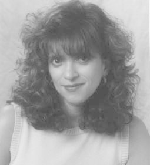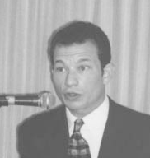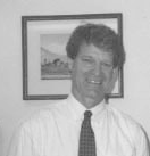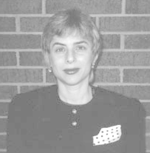PLAYERS IN THE JUDICIAL PROCESS
By Stuart Gorin and Bruce Carey
![]()
By Stuart Gorin and Bruce Carey
![]()
Besides the defendant in a trial, there are other players who bring their own unique perspectives to the process. In separate interviews, contributing editors Stuart Gorin and Bruce Carey talk with Assistant U.S. Attorney Rosa Rodriguez Mera, Southern District of Florida, on the role of the prosecutor; Martin Sabelli, a public defender in San Francisco discusses the fairly new civil right in the U.S. of the right to counsel in a criminal trial; Steve Mayo, a San Francisco attorney who serves as the director of the Institute for the Study of Legal Systems, comments on the process for jury selection; and Judge Laura Safer Espinoza, a New York state judge, explains the mechanics of the courtroom.
The Prosecutor
Federal prosecutors divide their cases into two major categories -- reactive and proactive -- says Assistant U.S. Attorney Rosa Rodriguez Mera, whose responsibilities include prosecuting narcotics cases in south Florida.

|
"Reactive cases are instantaneous: for example, a crime that has been committed at the airport involving drugs," Rodriguez Mera says. In proactive cases, which can be time-consuming, there is a lot of investigative work that is done before a person is arrested. These types of cases usually are pursued in cooperation with such federal agencies as the Drug Enforcement Administration, the Federal Bureau of Investigation and the U.S. Customs Service, Rodriguez Mera adds. When prosecutors interview law enforcement witnesses, she explains, the agents have to explain such things as how they carried out surveillance. Tapes and transcripts also are reviewed with informant witnesses who will be testifying in the case. |
In either event, says Rodriguez Mera, "it is the role of the U.S. Attorney's office to prosecute violations of federal law."
Once a crime has been committed and a suspect is in custody, the agent notifies the on-duty prosecutor, who determines what evidence there is for an arrest. Such questions as "Where were the drugs?" and "How do we know the defendant knew there were drugs in the suitcase?" are asked of the arresting agents. The prosecutor then contacts the magistrate judge on duty, who issues the arrest warrant and decides how much bond will be set for a defendant.
The defendant makes an initial appearance before the magistrate within 48 hours. At that hearing, an attorney is appointed to the defendant if he or she needs one; the defendant is informed of the charges and bond is set. Rodriguez Mera says that if a large amount of drugs is involved or there is a risk of flight or a danger to the community, then the government will request the suspect be held without bond. Otherwise, the judge can set bond in the case and free the defendant pending trial.
After the defendant has been indicted, if he or she decides to plead "not guilty," a number of steps can delay the start of a trial, including motions by the defense to suppress evidence -- which the judge rules upon -- and discovery -- when the prosecutor turns over copies of statements, lab reports, tapes or other evidence to the defense counsel.
Rodriguez Mera says on a case-by-case basis within set guidelines there is a small amount of discretion for "plea bargaining." In return for a guilty plea, for example, the government can ask for a lesser amount of prison time for a defendant if the defendant renders "substantial assistance in a case, such as cooperating against a co-defendant," she adds. As an example, she cites a case involving 10 kilos of cocaine, which carries a mandatory 10-year prison sentence. Rodriguez Mera says that if the defense provides substantial assistance, the government could file a motion requesting that the sentence be reduced, but she also points out that the judge does not have to accept the recommendation.
The Public Defender
The right to counsel in a criminal trial "is a relatively new civil right in the United States," says public defender Martin Sabelli, an attorney whose job it is to defend persons accused of federal crimes.
"At least at the state level," Sabelli continues, "in the long list of rights that the courts have inferred from the Constitution and have added to those originally written by the framers, this one can be traced only to the 1960s and has taken much of the past 30 years to develop effectively."
The right to counsel stems from the 1963 case of Clarence Gideon (Gideon v. Wainwright), a poor, uneducated man in Florida, who was accused of a minor crime. Gideon appeared in court without money or counsel and asked the court to appoint him a lawyer. But the judge refused because Florida law allowed court-appointed counsel only in cases that could carry the death penalty. Gideon was convicted and sentenced to prison, but appealed his case through the Florida state court system and eventually to the U.S. Supreme Court.
"That alone is a magnificent thing," Sabelli says. "For a poor man with little schooling to have the right to petition the courts all the way to the Supreme Court for an injustice he suffered tells much about the vital importance of protecting individual liberty in our system of law."
In Gideon's case, the Supreme Court ruled in a unanimous decision that every criminal defendant in both federal and state courts has a right to counsel, and if he cannot afford an attorney, then the court must appoint one. Gideon was given a lawyer and a new trial in Florida. With the help of his court-appointed counsel, Gideon was found not guilty.
The Gideon ruling is regarded as a landmark in the ongoing refinement and advancement of human rights, Sabelli says. "Gideon led to the development of the office of the public defender (P.D.) in both the federal court system and in all 50 states," he continues. "Under certain special circumstances, the court appoints a lawyer from a private firm to defend an accused person. But the bulk of ordinary indigent defendants get their lawyers from the P.D. office."

|
The public defender is, in fact, part of the court itself. "We are a part of the judiciary, and the judges oversee our operation to ensure proper ethical behavior and good administration," Sabelli points out. But no judge -- in fact, no person -- can interfere with the privileged relationship between a public defender and his client. And public defenders work harder knowing that their own presence will cause the prosecutor to work harder, Sabelli notes. Over the years, he has watched opposing counsel -- U.S. attorneys -- take greater care in preparing cases and treating the accused with fairness and dignity, when they know that a public defender is on the other side. |
"The right to counsel is the most basic rightof all," Sabelli concludes. "Without it, the other precious rights could not be guaranteed -- the 4th Amendment right to be free from unreasonable searches and seizures; the 5th Amendment right against double jeopardy and against self-incrimination, and the right to due process; the 6th Amendment right to a speedy public trial, to be allowed to confront witnesses, and to obtain favorable evidence. The right to counsel makes all the other rights possible," he says. And in the long run, "it gives us better justice and confidence in our government."
The Jury
The responsibility of the jury in the U.S. judicial process "is to make factual determinations," says Steve Mayo, a San Francisco attorney who serves as director of the Institute for the Study of Legal Systems. He notes that if there were no jury, then the judge would have to make all of the decisions in law and in fact. Instead, the jury makes its decisions based on facts presented during the trial, on the testimony of live witnesses, documents and arguments between the parties presented in court.
Selection of a jury of one's peers is a strictly random process, Mayo continues. The clerks of local court systems compile names from a number of lists, including, but not limited to, voter registration, automobile registration and driver's licenses. Anyone who is at least 18 years of age, is a U.S. citizen and has no felony conviction record is eligible, and is required to report to the courthouse on a given day as part of a jury pool. Some states require persons in the pool to return every day for a given length of time; others use a "one day or one trial" system, after which the citizen is excused from further duty. In either case, usually a person is not called back for several years.
Mayo says that on a typical day several hundred prospective jurors are called to a courthouse and are asked questions by the judge and the lawyers to determine their eligibility to serve. Examples of questions include "Do you speak and understand English?" and "Have you been the victim of a crime?"
In the criminal system, he says, the lawyers on both sides have a number of challenges to excuse prospective jurors without giving a specific reason why. Ultimately, they agree on 12 men and women to serve on a trial and also select three alternates who serve if one of the 12 has to drop out during the course of the trial. For civil cases, sometimes only six jurors are needed.
Occasionally -- often for some high-profile criminal cases -- a jury is "sequestered" for the length of the trial, Mayo says. That means the jury members cannot go home and are kept in hotel rooms where they do not have access to radio, television or newspapers so they cannot be influenced by what the media says about a case.

|
Immediately prior to a trial, Mayo says, the lawyers -- in agreement with the judge -- have to decide what evidence is going to be allowed to go to the jury. He adds that the lawyers also come up with "questions to put to jury members so when they go to deliberate they will have specific questions they factually have to answer." For example, he says a question in a civil case might be "Was the person negligent when he ran into the other car?" In a criminal case, a lawyer might ask "Did the defendant knowingly shoot the person?" |
Specific instructions of law to the jury also have to be worked out by the lawyers and the judge. Mayo says this could include such things as definitions of terms brought up during the trial, how to treat circumstantial evidence and how to treat expert witnesses.
Once the jury goes into deliberation, it selects a foreman from among its members. "This person serves as a moderator of the discussions," Mayo says, noting that "frequently people become very firm in their beliefs and they are not willing to listen to others present their views." The foreman allows everyone to make their views known and keeps the discussion on track.
Deliberations can take hours or even several days because decisions have to be unanimous. A mistrial can be declared if a jury cannot reach a verdict. In a criminal case, if a guilty verdict is reached, the sentence is usually handed down by the judge at a later date. And guilty or innocent, at the conclusion of the trial the jury is excused with the thanks of the court for carrying out its civic duty.
With very few exceptions, Mayo concludes, the jury system does its job properly, and the decisions reached are almost always the same as the judge would have determined if there had been no jury.
The Judge
"Judicial independence is of great importance" in the United States, and openness to the press and the public "is a good check on the judiciary," says Laura Safer Espinoza, a New York state judge. As such, the role of the judge under the common law system in the United States is as "a neutral, impartial finder of facts and in some cases a finder of the law as well."

|
This differs from the civil law system practiced in many other countries, Espinoza continues, where a judge "takes the role of investigator and formulator of charges as well as the trier of cases." She points out, however, that in both systems, in the event of a guilty finding, the judge usually determines the sentence. |
In a criminal trial in the United States, Espinoza notes, defendants have the right to face an accuser, opposing counsel have the right to cross-examine witnesses, and all of this takes place before a judge and/or jury, who make "independent determinations of fact" in the case. No judge is allowed to have exparte, or out-of-court conversations without both of the attorneys being present, she adds. "This is required by our code of ethics, and is a critical component to maintaining honesty and a lack of possibilities for corruption in the system."
Regarding courtroom decorum, Espinoza says that trials are open to the public and "any citizen has the right to observe what is taking place." She adds that the judge has to maintain order among both the spectators and the two sides in the trial, while moving the proceedings along. If attorneys do not behave in a professional manner, Espinoza says, the judge has the power to hold them in contempt of court, and they could face either a fine or a short jail sentence, though this rarely happens.
In recent years, a firestorm of controversy has erupted in the United States over whether or not to allow trials to be televised. It is an argument about the balance between the rights of the public to know about the case and the rights of the accused to a measure of privacy. Espinoza allows that the written press has a right to be in the courtroom, but she believes that cameras "can lead to a distortion of the proceedings," especially in high-profile cases. Different state legislatures set their own rules relating to TV in the courtroom, she says, but even where it is allowed, a judge still has the discretion to ban it in certain cases. By contrast, television cameras are not allowed in federal courtrooms.
The selection process for becoming a judge in the United States varies depending upon the state, but generally follows one of two main routes -- through popular election or appointment by a governor or mayor. In Espinoza's home state of New York, a candidate has to be a practicing attorney for a minimum of 10 years and face a merit-selection screening panel of representatives of law schools, bar associations and community organizations. The panels then pass to electoral officials names for consideration to be placed on ballots, or to the selecting official if the appointment system is used. Terms for judges in New York are for 10 years for lower courts and 14 years for higher courts. Depending upon their performance, judges then may or may not be reelected or reappointed.